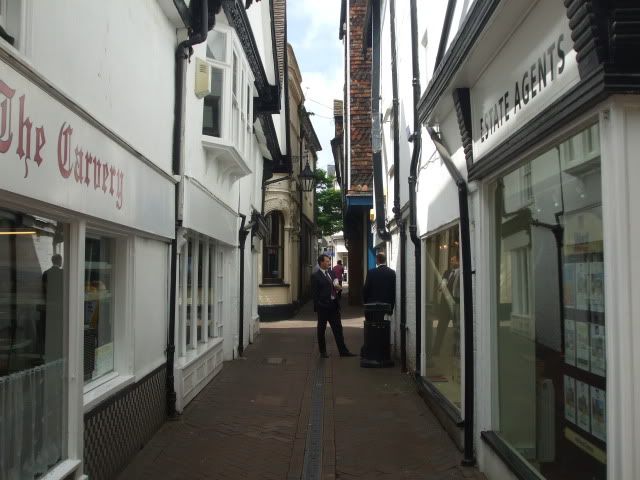I have to say I am glad that this project is back on and have been able to see places I will not make it too and look forward to many more stops and great photos. Thanks to all that have been a part of this project. David is going to be sending this on to Sjors that has his own G Shock blog and mentioned to me that I should start a blog on the G traveling all over the world. Here is his address. http://50-gs.blogspot.com/ Great G Shock photos and info.
Now for DavidS photos.
I live in Ashford, Kent, in the UK. Ashford grew up around the railway; there were at one point three different companies running trains through the town, each with their own line, station, carriage works etc, and a lot of this land still remains unused.

There are a lot of old railway buildings still standing, like these carriage works:

When these works were built, the railway company also built a model village to accommodate their employees. This is a view across the village green at 'Newtown':

The railway works are to be redeveloped, and a lot of the buildings have already been demolished (but would have been mainly engine sheds like the ones in the previous pictures). There are also a number of other ancillary buildings, like the clock tower at the main entrance to the works:

In the town centre a lot of the older buildings remain:


Although there is the mix of different ages of building found in so many British towns, with the inevitable shops built in the 60's/70's/80's – when town planners seem to have allowed anything, no matter how ugly, to be thrown up.

The church in the distance in the last picture, St Marys, is right in the middle of the town, but very well hidden away-I'd lived here some time before I even knew it existed.

One of the town's less salubrious drinking establishments:

A 'man of Kent' comes from the part of Kent East of the River Medway, a 'Kentish Man' from the part to the West.
Following the first World War, towns which had raised funds for the war effort were rewarded with a tank-Ashford's was driven into place in 1919 (but has since had it's engines and guns removed!), and for some years contained an electricity sub-station.

Another left-over from the war are these anti-tank defences, which would originally have been along the sides of roads or railway tracks. These ones, known as 'dragon's teeth' would have originally been alongside the railway line to Maidstone, and were removed when the Channel Tunnel Rail Link was built.

The River East Stour runs past the end of my road:

Further downstream the river merges with the Upper Great Stour to form the River Stour, which goes on through Canterbury and into the sea near Sandwich. Where the two rivers merge there is a mill:

No longer a working mill, the building is now used as a nightclub. This isn't the only mill in the town; the Willesborough Windmill is less than a mile away. It is open to the public, and a small amount of flour is still produced.

Running through Ashford is a 'green corridor'. This is made up of green spaces and parks, protected by the council from development (no great loss to developers, as it is prone to flooding!). In the largest of the parks stands the Hubert Fountain, originally constructed for the Second Great International Exhibition in 1862, and moved to the town in 1912.

The town centre has undergone a certain amount of redevelopment in recent years; a new shopping centre has been built, an controversially, some of what was the ring-road has been changed into a 'shared space'. The idea is that all barriers between vehicles and pedestrians are removed, as are signs, markings etc., and as a result road users show more consideration for each other. It even made the national press when Jeremy Clarkson put in his (un-suprisingly critical) tuppence worth.

As part of the town centre development, a number of pieces of installation art have been put in. My favourite of these is 'The Bolt', which serves as a mini-roundabout.

On the outskirts of the town stand the Eastwell Towers, originally the gatehouse for Eastwell Place which was a Royal residence for some time. The house has long since been demolished, and a hotel now stands in it's place.

The nearest church to my house:

This was built for the railwaymen; however, the pub directly across the road was finished a year earlier (the church is behind the trees in the background):

The railway is still central to Ashford. The Eurostar stops here, and there are direct services to Lile, Brussels, Calais & Paris. The 15:07 from Paris, leaving for St Pancras:

I decided to decide who to send the watch to next randomly, and threw a couple of die to decide. Then I realised that there were more people on the list than I'd thought, so I used a random number generator to pick. Amazingly both methods picked the same person! So tomorrow I'll be posting the watch to Sjors.





















 I cheated. Well, not really - the watch arrived as I was heading off to my home-town for the weekend. Just as well really - it's a lot prettier than Watford...
I cheated. Well, not really - the watch arrived as I was heading off to my home-town for the weekend. Just as well really - it's a lot prettier than Watford...






























